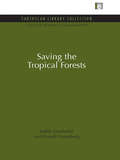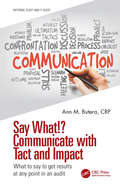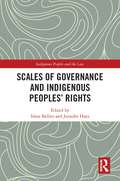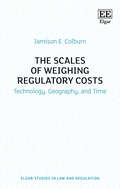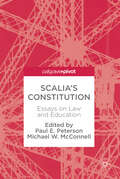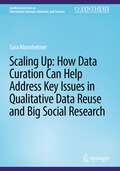- Table View
- List View
Saving the Protestant Ethic: Creative Class Evangelicalism and the Crisis of Work
by Andrew LynnProtestant orientations to work and economics have shaped wider American culture for several centuries. But not all strands of American Protestantism have elevated secular work to the highest echelons of spiritual significance. This book surveys the efforts of a religious movement within white Protestant fundamentalism and its neo-evangelical successors to "make work matter to God." Today, bearing the name the "faith and work movement," this effort puts on display the creative capacities of religious and lay leaders to adapt a faith system to the changing social-economic conditions of advanced capitalism. Building from the insights and theory of Max Weber, Andrew Lynn draws on archival research and interviews with movement leaders to survey and assess the surging number of new organizations, books, conferences, worship songs, seminary classes, vocational programming, and study groups promoting classically Protestant and Calvinist ideas of work and vocation. He traces these efforts back to early-twentieth-century business leaders and theologically trained leaders who saw a desperate need to foster a new "work ethic" among religious laity entering into professional, managerial, and creative class work. Leaders interviewed for the study recount the challenges of rerouting energies that were previously steered toward inward spirituality, cultural separatism, and proselytization. Through these interviews, Saving the Protestant Ethic captures ongoing in-group tensions and creative adaptation among American evangelicals as they navigate changing class and political dynamics that shape American society.
Saving the Protestant Ethic: Creative Class Evangelicalism and the Crisis of Work
by Andrew LynnProtestant orientations to work and economics have shaped wider American culture for several centuries. But not all strands of American Protestantism have elevated secular work to the highest echelons of spiritual significance. This book surveys the efforts of a religious movement within white Protestant fundamentalism and its neo-evangelical successors to "make work matter to God." Today, bearing the name the "faith and work movement," this effort puts on display the creative capacities of religious and lay leaders to adapt a faith system to the changing social-economic conditions of advanced capitalism. Building from the insights and theory of Max Weber, Andrew Lynn draws on archival research and interviews with movement leaders to survey and assess the surging number of new organizations, books, conferences, worship songs, seminary classes, vocational programming, and study groups promoting classically Protestant and Calvinist ideas of work and vocation. He traces these efforts back to early-twentieth-century business leaders and theologically trained leaders who saw a desperate need to foster a new "work ethic" among religious laity entering into professional, managerial, and creative class work. Leaders interviewed for the study recount the challenges of rerouting energies that were previously steered toward inward spirituality, cultural separatism, and proselytization. Through these interviews, Saving the Protestant Ethic captures ongoing in-group tensions and creative adaptation among American evangelicals as they navigate changing class and political dynamics that shape American society.
Saving the Seed: Genetic diversity and European agriculture (Natural Resource Management Set)
by Renee VellveGenetic diversity is essential to the security of agriculture. Without the availability of a wide range of plant varieties and the genetic resources they contain, crops cannot adapt to combat the ever-changing threats of pests, diseases and climatic change. Yet, with the increasing industrialisation of modern agriculture, farming has become a business which centres on a handful of new, genetically similar 'super seeds'. Plants must evolve in order to survive, but modern agriculture has replaced diversity with uniformity, and security with vulnerability. Saving the Seed traces the decline of crop varieties in European farming and describes what is being done to safeguard genetic resources for the future. Conservation efforts by government and industry suffer from serious drawbacks, with wrangles over ownership and control of resources. The crucial work is being done by individuals and grassroots organisations, who largely go unrecognised and under-resourced. What is urgently needed are sound policies to promote the diversification of agriculture and an integrated strategy for safeguarding the genetic base of our food system. Saving the Seed contains the most up-to-date information available on genetic resources in Europe and on those working to save them. Renee Vellve is a researcher at GRAIN, a no-governmental organisation working to promote the sustainable conservation and use of genetic diversity, based on grassroots approaches to genetic resources management. Originally published in 1992
Saving the Seed: Genetic diversity and European agriculture (Natural Resource Management Set)
by Renee VellveGenetic diversity is essential to the security of agriculture. Without the availability of a wide range of plant varieties and the genetic resources they contain, crops cannot adapt to combat the ever-changing threats of pests, diseases and climatic change. Yet, with the increasing industrialisation of modern agriculture, farming has become a business which centres on a handful of new, genetically similar 'super seeds'. Plants must evolve in order to survive, but modern agriculture has replaced diversity with uniformity, and security with vulnerability. Saving the Seed traces the decline of crop varieties in European farming and describes what is being done to safeguard genetic resources for the future. Conservation efforts by government and industry suffer from serious drawbacks, with wrangles over ownership and control of resources. The crucial work is being done by individuals and grassroots organisations, who largely go unrecognised and under-resourced. What is urgently needed are sound policies to promote the diversification of agriculture and an integrated strategy for safeguarding the genetic base of our food system. Saving the Seed contains the most up-to-date information available on genetic resources in Europe and on those working to save them. Renee Vellve is a researcher at GRAIN, a no-governmental organisation working to promote the sustainable conservation and use of genetic diversity, based on grassroots approaches to genetic resources management. Originally published in 1992
Saving the Tropical Forests (Natural Resource Management Set)
by Judith Gradwohl Russell GreenbergThe destruction of the tropical forest is one of the major problems of our time. Vast areas are rapidly becoming wastelands which support only a few tough weeds, perhaps some cattle, and the farms allowed to the poor. This book provides a vision of hope: in Latin America. Africa. And South East Asia, growing numbers of people are developing techniques specifically designed to promote the wise use and preservation of remaining forest lands. However, these grassroots strategies are often ignored in favour of grandiose schemes which inevitably fail. This pattern must be broken now or the tropical forests will be lost forever. Published in association with the Smithsonian Institution. Preface by Michael Robinson, Director, National Zoological Park. Smithsonian Institution Originally published in 1988
Saving the Tropical Forests (Natural Resource Management Set)
by Judith Gradwohl Russell GreenbergThe destruction of the tropical forest is one of the major problems of our time. Vast areas are rapidly becoming wastelands which support only a few tough weeds, perhaps some cattle, and the farms allowed to the poor. This book provides a vision of hope: in Latin America. Africa. And South East Asia, growing numbers of people are developing techniques specifically designed to promote the wise use and preservation of remaining forest lands. However, these grassroots strategies are often ignored in favour of grandiose schemes which inevitably fail. This pattern must be broken now or the tropical forests will be lost forever. Published in association with the Smithsonian Institution. Preface by Michael Robinson, Director, National Zoological Park. Smithsonian Institution Originally published in 1988
Saviour Siblings: A Relational Approach to the Welfare of the Child in Selective Reproduction (Biomedical Law and Ethics Library)
by Michelle Taylor-SandsGenetic screening technologies involving pre-implantation genetic diagnosis (PGD) raise particular issues about selective reproduction and the welfare of the child to be born. How does selection impact on the identity of the child who is born? Are children who are selected for a particular purpose harmed or treated as commodities? How far should the state interfere with parents’ reproductive choices? Currently, concerns about the welfare of the child in selective reproduction have focused on the individual interests of the child to be born. This book re-evaluates the welfare of the child through the controversial topic of saviour sibling selection. Drawing on relational feminist and communitarian ethics, Michelle Taylor-Sands argues that the welfare of the child to be born is inextricably linked with the welfare of his/her family. The author proposes a relational model for selective reproduction based on a broad conception of the welfare of the child that includes both individual and collective family interests. By comparing regulation in the UK and Australia, the book maps out how law and policy might support a relational model for saviour sibling selection. With an interdisciplinary focus, Saviour Siblings: A Relational Approach to the Welfare of the Child in Selective Reproduction will be of particular interest to academics and students of bioethics and law as well as practitioners and policymakers concerned with the ethics of selective reproduction.
Saviour Siblings: A Relational Approach to the Welfare of the Child in Selective Reproduction (Biomedical Law and Ethics Library)
by Michelle Taylor-SandsGenetic screening technologies involving pre-implantation genetic diagnosis (PGD) raise particular issues about selective reproduction and the welfare of the child to be born. How does selection impact on the identity of the child who is born? Are children who are selected for a particular purpose harmed or treated as commodities? How far should the state interfere with parents’ reproductive choices? Currently, concerns about the welfare of the child in selective reproduction have focused on the individual interests of the child to be born. This book re-evaluates the welfare of the child through the controversial topic of saviour sibling selection. Drawing on relational feminist and communitarian ethics, Michelle Taylor-Sands argues that the welfare of the child to be born is inextricably linked with the welfare of his/her family. The author proposes a relational model for selective reproduction based on a broad conception of the welfare of the child that includes both individual and collective family interests. By comparing regulation in the UK and Australia, the book maps out how law and policy might support a relational model for saviour sibling selection. With an interdisciplinary focus, Saviour Siblings: A Relational Approach to the Welfare of the Child in Selective Reproduction will be of particular interest to academics and students of bioethics and law as well as practitioners and policymakers concerned with the ethics of selective reproduction.
Saviour Siblings and the Regulation of Assisted Reproductive Technology: Harm, Ethics and Law
by Malcolm K. SmithAdvances in the field of Assisted Reproductive Technology (ART) have been revolutionary. This book focuses on the use of ARTs in the context of families who seek to conceive a matching sibling donor as a source of tissue to treat an existing sick child. Such children have been referred to as 'saviour siblings'. Considering the legal and regulatory frameworks that impact on the accessibility of this technology in Australia and the UK, the work analyses the ethical and moral issues that arise from the use of the technology for this specific purpose. The author claims the only justification for limiting a family's reproductive liberty in this context is where the exercise of reproductive decision-making results in harm to others. It is argued that the harm principle is the underlying feature of legislative action in Western democratic society, and as such, this principle provides the grounds upon which a strong and persuasive argument is made for a less-restrictive regulatory approach in the context of 'saviour siblings'. The book will be of great relevance and interest to academics, researchers, practitioners and policy makers in the fields of law, ethics, philosophy, science and medicine.
Saviour Siblings and the Regulation of Assisted Reproductive Technology: Harm, Ethics and Law
by Malcolm K. SmithAdvances in the field of Assisted Reproductive Technology (ART) have been revolutionary. This book focuses on the use of ARTs in the context of families who seek to conceive a matching sibling donor as a source of tissue to treat an existing sick child. Such children have been referred to as 'saviour siblings'. Considering the legal and regulatory frameworks that impact on the accessibility of this technology in Australia and the UK, the work analyses the ethical and moral issues that arise from the use of the technology for this specific purpose. The author claims the only justification for limiting a family's reproductive liberty in this context is where the exercise of reproductive decision-making results in harm to others. It is argued that the harm principle is the underlying feature of legislative action in Western democratic society, and as such, this principle provides the grounds upon which a strong and persuasive argument is made for a less-restrictive regulatory approach in the context of 'saviour siblings'. The book will be of great relevance and interest to academics, researchers, practitioners and policy makers in the fields of law, ethics, philosophy, science and medicine.
Say What!? Communicate with Tact and Impact: What to say to get results at any point in an audit (Internal Audit and IT Audit)
by Ann M. ButeraThis book addresses the important role of communication within the context of performing an audit, project, or review (i.e., planning, detailed testing, and reporting). Intended for audit, information security, enterprise, and operational risk professionals at all levels, including those just starting out, Say What!? Communicate with Tact and Impact: What to Say to Get Results at Any Point in an Audit contains an array of practical and time-tested approaches that foster efficient and effective communication at any point during an engagement. The practical and memorable techniques are culled from author Ann M. Butera’s CRP experience as a trusted advisor who has taught thousands of professionals how to develop and hone their interpersonal, communication, and empathic skills. Those familiar with the Five Tier Competency ModelTM she developed will recognize these techniques as a deep dive on the competencies comprising Tier 3: Project Management and Tier 5: Managing Constituent Relations. The author discusses the following behaviors in one’s dealings with executives, process owners, control performers, and colleagues: Demonstrating executive presence Becoming the trusted advisor Influencing others Communicating with tact, confidence, and impact Facilitating productive meetings and discussions Overcoming resistance and objections Managing and resolving conflict Knowing when to let a topic go and move on This book is a guide for professionals who want to interact proactively and persuasively with those they work with, audit, or review. It describes techniques that can be used during virtual, in-person, telephone, or video conferences (as opposed to emails, workpapers, and reports). It provides everyone (newer associates in particular) with the interpersonal skills needed to (1) develop and build relationships with their internal constituents and clients, (2) facilitate conversations and discussions before and during meetings, and (3) handle impromptu questions with confidence and executive presence and make positive first impressions. The topics and techniques discussed are accompanied by case studies, examples, and exercises to give the readers the opportunity to develop plans to bridge the gap between theory and practice. The readers can use the book as a reliable resource when subject matter experts or training guides are not readily available.
Say What!? Communicate with Tact and Impact: What to say to get results at any point in an audit (Internal Audit and IT Audit)
by Ann M. ButeraThis book addresses the important role of communication within the context of performing an audit, project, or review (i.e., planning, detailed testing, and reporting). Intended for audit, information security, enterprise, and operational risk professionals at all levels, including those just starting out, Say What!? Communicate with Tact and Impact: What to Say to Get Results at Any Point in an Audit contains an array of practical and time-tested approaches that foster efficient and effective communication at any point during an engagement. The practical and memorable techniques are culled from author Ann M. Butera’s CRP experience as a trusted advisor who has taught thousands of professionals how to develop and hone their interpersonal, communication, and empathic skills. Those familiar with the Five Tier Competency ModelTM she developed will recognize these techniques as a deep dive on the competencies comprising Tier 3: Project Management and Tier 5: Managing Constituent Relations. The author discusses the following behaviors in one’s dealings with executives, process owners, control performers, and colleagues: Demonstrating executive presence Becoming the trusted advisor Influencing others Communicating with tact, confidence, and impact Facilitating productive meetings and discussions Overcoming resistance and objections Managing and resolving conflict Knowing when to let a topic go and move on This book is a guide for professionals who want to interact proactively and persuasively with those they work with, audit, or review. It describes techniques that can be used during virtual, in-person, telephone, or video conferences (as opposed to emails, workpapers, and reports). It provides everyone (newer associates in particular) with the interpersonal skills needed to (1) develop and build relationships with their internal constituents and clients, (2) facilitate conversations and discussions before and during meetings, and (3) handle impromptu questions with confidence and executive presence and make positive first impressions. The topics and techniques discussed are accompanied by case studies, examples, and exercises to give the readers the opportunity to develop plans to bridge the gap between theory and practice. The readers can use the book as a reliable resource when subject matter experts or training guides are not readily available.
Scales of Governance and Indigenous Peoples' Rights: New Rights or Same Old Wrongs? (Indigenous Peoples and the Law)
by Irene Bellier Jennifer HaysThis book takes an interdisciplinary approach to the complicated power relations surrounding the recognition and implementation of Indigenous Peoples’ rights at multiple scales. The adoption of the United Nations Declaration on the Rights of Indigenous Peoples in 2007 was heralded as the beginning of a new era for Indigenous Peoples’ participation in global governance bodies, as well as for the realization of their rights – in particular, the right to self-determination. These rights are defined and agreed upon internationally, but must be enacted at regional, national, and local scales. Can the global movement to promote Indigenous Peoples’ rights change the experience of communities at the local level? Or are the concepts that it mobilizes, around rights and political tools, essentially a discourse circulating internationally, relatively disconnected from practical situations? Are the categories and processes associated with Indigenous Peoples simply an extension of colonial categories and processes, or do they challenge existing norms and structures? This collection draws together the works of anthropologists, political scientists, and legal scholars to address such questions. Examining the legal, historical, political, economic, and cultural dimensions of the Indigenous Peoples' rights movement, at global, regional, national, and local levels, the chapters present a series of case studies that reveal the complex power relations that inform the ongoing struggles of Indigenous Peoples to secure their human rights. The book will be of interest to social scientists and legal scholars studying Indigenous Peoples’ rights, and international human rights movements in general.
Scales of Governance and Indigenous Peoples' Rights: New Rights or Same Old Wrongs? (Indigenous Peoples and the Law)
This book takes an interdisciplinary approach to the complicated power relations surrounding the recognition and implementation of Indigenous Peoples’ rights at multiple scales. The adoption of the United Nations Declaration on the Rights of Indigenous Peoples in 2007 was heralded as the beginning of a new era for Indigenous Peoples’ participation in global governance bodies, as well as for the realization of their rights – in particular, the right to self-determination. These rights are defined and agreed upon internationally, but must be enacted at regional, national, and local scales. Can the global movement to promote Indigenous Peoples’ rights change the experience of communities at the local level? Or are the concepts that it mobilizes, around rights and political tools, essentially a discourse circulating internationally, relatively disconnected from practical situations? Are the categories and processes associated with Indigenous Peoples simply an extension of colonial categories and processes, or do they challenge existing norms and structures? This collection draws together the works of anthropologists, political scientists, and legal scholars to address such questions. Examining the legal, historical, political, economic, and cultural dimensions of the Indigenous Peoples' rights movement, at global, regional, national, and local levels, the chapters present a series of case studies that reveal the complex power relations that inform the ongoing struggles of Indigenous Peoples to secure their human rights. The book will be of interest to social scientists and legal scholars studying Indigenous Peoples’ rights, and international human rights movements in general.
Scales of Memory: Constitutional Justice and Historical Evil (Oxford Comparative Constitutionalism)
by Justin CollingsSince the Second World War, constitutional justice has spread through much of the democratic world. Often it has followed in the wake of national calamity and historical evil - whether fascism or communism, colonialism or apartheid. Unsurprisingly, the memory of such evils plays a prominent role in constitutional adjudication. This book explores the relationship between constitutional interpretation and the memory of historical evil. Specifically, it examines how the constitutional courts of the United States, Germany, and South Africa have grappled, respectively, with the legacies of slavery, Nazism, and apartheid. Most courts invoke historical evil through either the parenthetical or the redemptive mode of constitutional memory. The parenthetical framework views the evil era as exceptional - a baleful aberration from an otherwise noble and worthy constitutional tradition. Parenthetical jurisprudence reaches beyond the evil era toward stable and enduring values. It sees the constitutional response to evil as restorative rather than revolutionary - a return to and reaffirmation of older traditions. The redemptive mode, by contrast, is more aggressive. Its aim is not to resume a venerable tradition but to reverse recent ills. Its animating spirit is not restoration, but antithesis. Its aim is not continuity with deeper pasts, but a redemptive future stemming from a stark, complete, and vivid rupture. This book demonstrates how, across the three jurisdictions, the parenthetical mode has often accompanied formalist and originalist approaches to constitutional interpretation, whereas the redemptive mode has accompanied realist and purposive approaches. It also shows how, within the three jurisdictions, the parenthetical mode of memory has consistently predominated in American constitutional jurisprudence; the redemptive mode in South African jurisprudence; and a hybrid, parenthetical-redemptive mode in German constitutional jurisprudence. The real-world consequences of these trends have been stark and dramatic. Memory matters, especially in constitutional interpretation.
Scales of Memory: Constitutional Justice and Historical Evil (Oxford Comparative Constitutionalism)
by Justin CollingsSince the Second World War, constitutional justice has spread through much of the democratic world. Often it has followed in the wake of national calamity and historical evil - whether fascism or communism, colonialism or apartheid. Unsurprisingly, the memory of such evils plays a prominent role in constitutional adjudication. This book explores the relationship between constitutional interpretation and the memory of historical evil. Specifically, it examines how the constitutional courts of the United States, Germany, and South Africa have grappled, respectively, with the legacies of slavery, Nazism, and apartheid. Most courts invoke historical evil through either the parenthetical or the redemptive mode of constitutional memory. The parenthetical framework views the evil era as exceptional - a baleful aberration from an otherwise noble and worthy constitutional tradition. Parenthetical jurisprudence reaches beyond the evil era toward stable and enduring values. It sees the constitutional response to evil as restorative rather than revolutionary - a return to and reaffirmation of older traditions. The redemptive mode, by contrast, is more aggressive. Its aim is not to resume a venerable tradition but to reverse recent ills. Its animating spirit is not restoration, but antithesis. Its aim is not continuity with deeper pasts, but a redemptive future stemming from a stark, complete, and vivid rupture. This book demonstrates how, across the three jurisdictions, the parenthetical mode has often accompanied formalist and originalist approaches to constitutional interpretation, whereas the redemptive mode has accompanied realist and purposive approaches. It also shows how, within the three jurisdictions, the parenthetical mode of memory has consistently predominated in American constitutional jurisprudence; the redemptive mode in South African jurisprudence; and a hybrid, parenthetical-redemptive mode in German constitutional jurisprudence. The real-world consequences of these trends have been stark and dramatic. Memory matters, especially in constitutional interpretation.
The Scales of Weighing Regulatory Costs: Technology, Geography, and Time (Elgar Studies in Law and Regulation)
by Jamison E. ColburnThis book examines the calculation and evaluation of regulatory costs by regulators in accordance with a legislative mandate. A serious limitation in that enterprise, the possibility of technological change and innovation, often compromises those efforts and has long been under-appreciated in standard ‘cost-benefit analysis.’ Regulators who study the inducement of innovation and the avoidance of regulatory costs by the regulated often find significant cost-saving opportunities, leading to more stringent and more effective risk governance. Ultimately, the weighing of costs in this more elaborate model is more than simple welfare maximization. It views regulatory costs as important to society for a range of reasons, some grounded in fairness and some in deliberative process values, as a society seeks to minimize all costs over time. This analysis places the weighing of regulatory costs in context by comparing cost calculation methods and evaluative tools in three illuminating case studies. It assesses cost-factoring methods under different normative frameworks and highlights the role of technological innovation in cost minimization over time while considering regulatory costs that result from multiple regulatory tool choices. A single regulatory cost investigation is tracked from agency to legislative back to agency choice, outlining the steps to consensus-oriented cost factoring methods. Academic and professional lawyers in fields like environmental protection, food and drug safety, and workplace safety will find this an invaluable resource, as will researchers in disciplines dealing with judicial choice from economic or political theoretical frameworks and regulatory agencies charged with regulating risks.
Scalia’s Constitution: Essays on Law and Education
by Paul E. Peterson and Michael W. McConnellThis book explores the application of Scalia’s textualism and originalism to education law and reflects upon Scalia’s teachings and his pedagogy. Education law may seem to be an odd vehicle for considering Scalia’s constitutional approach, but thinking about schools requires attention to political fundamentals—freedom of speech, free exercise of religion, equality of opportunity, federalism, and the proper role of the expert. Legal scholars, philosophers, and political scientists provide both critiques and apologies for Scalia’s approach.
Scaling Social Innovation Through Cross-Sector Social Partnerships: Driving Optimal Performance
by Thomas G. Pittz Melissa L. IntindolaThis book is designed to illuminate the features of cross-sector partnerships that make them powerful vehicles to drive social change. Partnerships across market sectors, involving for-profit, non-profit, and government entities, work because they leverage the advantages of each type of organization to arrive at novel solutions to social problems. Unlike previous work that has discussed cross-sector, multi-sector, or public-private partnerships at a conceptual level, this book scours the existing literature and explores real-life examples to demonstrate the practical characteristics that render these partnerships effective at tackling obstreperous social problems. The authors delve into the key formative features of cross-sector partnerships such as leadership, motivation, cooperative capabilities, and arrive at distinct characteristics that drive performance. The authors lay out a succinct roadmap for creating and maintaining viable cross-sector social partnerships, with instructive real-life examples that highlight how these partnerships can be executed effectively.
Scaling Social Innovation Through Cross-Sector Social Partnerships: Driving Optimal Performance
by Thomas G. Pittz Melissa L. IntindolaThis book is designed to illuminate the features of cross-sector partnerships that make them powerful vehicles to drive social change. Partnerships across market sectors, involving for-profit, non-profit, and government entities, work because they leverage the advantages of each type of organization to arrive at novel solutions to social problems. Unlike previous work that has discussed cross-sector, multi-sector, or public-private partnerships at a conceptual level, this book scours the existing literature and explores real-life examples to demonstrate the practical characteristics that render these partnerships effective at tackling obstreperous social problems. The authors delve into the key formative features of cross-sector partnerships such as leadership, motivation, cooperative capabilities, and arrive at distinct characteristics that drive performance. The authors lay out a succinct roadmap for creating and maintaining viable cross-sector social partnerships, with instructive real-life examples that highlight how these partnerships can be executed effectively.
Scaling up Business Solutions to Social Problems: A Practical Guide for Social and Corporate Entrepreneurs
by O. Kayser V. BudinichA silent revolution is underway, as entrepreneurs challenge prevalent notions of business motives and methods to invent market-based solutions to eradicate social injustice. Yet many fail to succeed. Based on original research, the authors uncover why impressive solutions fail to scale up, featuring global case studies and practical solutions.
Scaling Up: How Data Curation Can Help Address Key Issues in Qualitative Data Reuse and Big Social Research (Synthesis Lectures on Information Concepts, Retrieval, and Services)
by Sara MannheimerThis book explores the connections between qualitative data reuse, big social research, and data curation. A review of existing literature identifies the key issues of context, data quality and trustworthiness, data comparability, informed consent, privacy and confidentiality, and intellectual property and data ownership. Through interviews of qualitative researchers, big social researchers, and data curators, the author further examines each key issue and produces new insights about how domain differences affect each community of practice’s viewpoints, different strategies that researchers and curators use to ensure responsible practice, and different perspectives on data curation. The book suggests that encouraging connections between qualitative researchers, big social researchers, and data curators can support responsible scaling up of social research, thus enhancing discoveries in social and behavioral science.
Scamell and Gasztowicz on Land Covenants
by Steven Gasztowicz KCThis book covers a complex and broad area of law for property lawyers to contend with. Dealing with the impact of covenants on land affects most conveyancing transactions and is also of vital importance to landowners, developers and others. The volume of case law on this topic is extensive.This book includes coverage of positive covenants and planning covenants and is updated to include the major Supreme Court case on restrictive covenants, Alexander Devine Children's Cancer Trust v Housing Solutions Ltd [2020] 1 WLR 4783 and other major Court of Appeal decisions. It also deals with the special position of local authorities in relation to land covenants, and has coverage on freeing land from restrictions.The book is divided into four main parts: Part I – Restrictive Covenants; Part II – Positive and Negative Covenants; Part III - Planning Obligations;Part IV - Reform.This title is included in Bloomsbury Professional's Property and Land Law online service.
Scandal and Corruption in Congress
by Michael J. Pomante IiRegardless of which political party Americans identify with, the sentiment that those who work in Washington are corrupt transcends partisanship. Since the breaking of the Watergate scandal, trust in the government has decreased significantly. While Congress did not engage in the Watergate break-in, the institution has still suffered the consequences, seeing citizens' distrust of politicians grow. However, Congress is not blameless, as it has had its share of scandal and corruption over the years. Scandal and Corruption in Congress guides readers through the history of corruption in Congress. Specifically, readers explore policies outlawing corruption, how Congress has attempted to hide unethical behaviour, getting caught, the repercussions of getting caught, and how corruption in the U.S. compares to corruption in other nations. Finally, to enlighten readers about the recent actions by Congress, several chapters address the impact of Citizens United and the #MeToo movement.
Scandal and Corruption in Congress
by Michael J. Pomante IIRegardless of which political party Americans identify with, the sentiment that those who work in Washington are corrupt transcends partisanship. Since the breaking of the Watergate scandal, trust in the government has decreased significantly. While Congress did not engage in the Watergate break-in, the institution has still suffered the consequences, seeing citizens' distrust of politicians grow. However, Congress is not blameless, as it has had its share of scandal and corruption over the years. Scandal and Corruption in Congress guides readers through the history of corruption in Congress. Specifically, readers explore policies outlawing corruption, how Congress has attempted to hide unethical behaviour, getting caught, the repercussions of getting caught, and how corruption in the U.S. compares to corruption in other nations. Finally, to enlighten readers about the recent actions by Congress, several chapters address the impact of Citizens United and the #MeToo movement.


